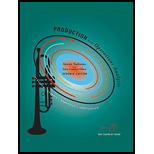
Concept explainers
a)
Interpretation: probabilities of no customer in 5 mins.
Concept introduction: Poisson arrivals are a reasonably good assumption for unscheduled systems. Further if there is a mix of many different types of jobs the exponential distribution can be realistic for service times. Otherwise it tends to be too variable of a distribution.
b)
Interpretation: probabilities of exactly one customer in a min.
Concept introduction: Poisson arrivals are a reasonably good assumption for unscheduled systems. Further if there is a mix of many different types of jobs the exponential distribution can be realistic for service times. Otherwise it tends to be too variable of a distribution.
c)
Interpretation: probabilities of exactly two customers in 2mins.
Concept introduction: Poisson arrivals are a reasonably good assumption for unscheduled systems. Further if there is a mix of many different types of jobs the exponential distribution can be realistic for service times. Otherwise it tends to be too variable of a distribution.
d)
Interpretation: probability of at least two customers in 10 mins.
Concept introduction: Poisson arrivals are a reasonably good assumption for unscheduled systems. Further if there is a mix of many different types of jobs the exponential distribution can be realistic for service times. Otherwise it tends to be too variable of a distribution.
Want to see the full answer?
Check out a sample textbook solution
Chapter 7 Solutions
Production and Operations Analysis, Seventh Edition
- new shopping mall is considering setting up an information desk manned by one employee. Based upon information obtained from similar information desks, it is believed that people will arrive at the desk at a rate of 20 per hour. It takes an average of 2 minutes to answer a question. It is assumed that the arrivals follow a Poisson distribution and answer times are exponentially distributed. Find the probability that the employee is idle. Find the proportion of the time that the employee is busy. Find the average number of people receiving and waiting to receive some information. Find the average number of people waiting in line to get some information. Find the average time a person seeking information spends in the system. Find the expected time a person spends just waiting in line to have a question answered (time in the queue).arrow_forwardA cafeteria serving line has a coffee urn from which customers serve themselves. Arrivals at the urn follow a Poisson distribution at the rate of three per minute. In serving themselves, customers take about 15 seconds, exponentially distributed.a. How many customers would you expect to see, on average, at the coffee urn?b. How long would you expect it to take to get a cup of coffee?c. What percentage of time is the urn being used?d. What is the probability that three or more people are in the cafeteria?e. If the cafeteria installs an automatic vendor that dispenses a cup of coffee at a constanttime of 15 seconds, how does this change your answers to (a) and (b)?arrow_forward
 Practical Management ScienceOperations ManagementISBN:9781337406659Author:WINSTON, Wayne L.Publisher:Cengage,
Practical Management ScienceOperations ManagementISBN:9781337406659Author:WINSTON, Wayne L.Publisher:Cengage,
